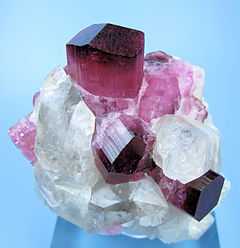Elbaite
| Elbaite | |
|---|---|
|
Elbaite from Male, Mogok, Sagaing, Mandalay, Myanmar (size: 61 x 60 x 52 mm, 198 g) | |
| General | |
| Category | Silicate mineral |
| Formula (repeating unit) | Na(Li1.5Al1.5)Al6Si6O18(BO3)3(OH)4 |
| Strunz classification | 09.CK.05 |
| Identification | |
| Color | Green, red to pink, blue, orange, yellow, colorless, multicolored |
| Crystal habit | Prismatic; striated |
| Crystal system | Trigonal |
| Cleavage | Poor/indistinct on {1120} and {1011} |
| Fracture | Sub-conchoidal |
| Mohs scale hardness | 7½ |
| Luster | Vitreous |
| Streak | White |
| Diaphaneity | Transparent to opaque |
| Density | 2.9–3.2 |
| Optical properties | Uniaxial (-) |
| Refractive index | nω = 1.635–1.650, nε = 1.615–1.632 |
| Birefringence | δ = 0.020 |
| Other characteristics | piezoelectric and pyroelectric |
| References | [1][2] |
| Major varieties | |
| Achroite | colorless |
| Indicolite | blue |
| Rubellite | red to pink |
| Verdelite | green |

Elbaite, a sodium, lithium, aluminium boro-silicate, is a mineral species belonging to the six member ring cyclosilicate tourmaline group, with the following general composituion: Na(Li1.5Al1.5)Al6Si6O18(BO3)3(OH)4 [3]
Elbaite forms three series, with dravite, with fluor-liddicoatite, and with schorl. Due to these series, specimens with the ideal end-member formula are not found occurring naturally.
As a gemstone, elbaite is a desirable member of the tourmaline group because of the variety and depth of its colours and quality of the crystals. Originally discovered on the island of Elba, Italy in 1913, it has since been found in many parts of the world. In 1994, a major locality was discovered in Canada, at O'Grady Lakes in the Yukon.
Elbaite forms in igneous and metamorphic rocks and veins in association with lepidolite, microcline, and spodumene in granite pegmatites; with andalusite and biotite in schist; and with molybdenite and cassiterite in massive hydrothermal replacement deposits.
Elbaite is allochromatic, meaning trace amounts of impurities can tint crystals, and it can be strongly pleochroic. Every color of the rainbow may be represented by elbaite, some exhibiting multicolor zonation. Microscopic acicular inclusions in some elbaite crystals show the Cat's eye effect in polished cabochons.
- Elbaite varieties:
- Red or pinkish-red; rubellite variety (from ruby)
- Light blue to bluish green; Brazilian indicolite variety (from indigo)
- Green—verdelite or Brazilian emerald variety
- Colorless—achroite variety (from the Greek "άχρωμος" meaning "colorless")
- Watermelon tourmaline is a zoned variety with a reddish center surrounded by a green outer zone resembling watermelon rind, evident in cross section slices of prisms, often displaying curved sides.
References

| Wikimedia Commons has media related to Elbaite. |
